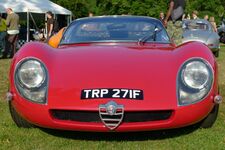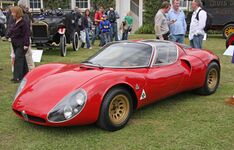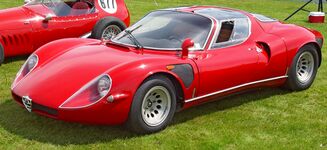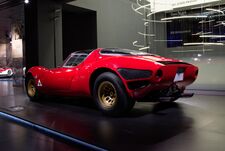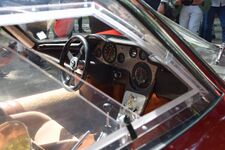Engineering:Alfa Romeo 33 Stradale
| Alfa Romeo 33 Stradale | |
|---|---|
 | |
| Overview | |
| Manufacturer | Alfa Romeo |
| Production | November 1967 – March 1969 18 produced |
| Assembly | Milan, Italy (Carrozzeria Marazzi) |
| Designer | Franco Scaglione[1] |
| Body and chassis | |
| Class | Sports car |
| Body style | 2-door coupé |
| Layout | Rear mid-engine, rear-wheel drive |
| Doors | Butterfly |
| Related | Alfa Romeo Tipo 33 |
| Powertrain | |
| Engine | 2.0 L V8 |
| Transmission | 6-speed manual |
| Dimensions | |
| Wheelbase | 2,350 mm (92.5 in) |
| Length | 3,970 mm (156.3 in) |
| Width | 1,710 mm (67.3 in) |
| Height | 991 mm (39.0 in) |
| |uk|Kerb|Curb}} weight | 700 kg (1,543 lb) |
| Chronology | |
| Successor | Alfa Romeo 33 Stradale (spiritual) |
The Alfa Romeo 33 Stradale is a mid-engine sports car built by Italian automobile manufacturer Alfa Romeo. It was the fastest commercially available car for the standing kilometer upon its introduction.[2][3][4] 18 examples were produced between 1967 and 1969. "Stradale" (Italian for "road-going") is a term often used by Italian car manufacturers to indicate a street-legal version of a racing car; indeed the 33 Stradale was derived from the Tipo 33 sports prototype. Built in an attempt by Alfa Romeo to make some of its racing technology available to the public, it was also the most expensive automobile for sale to the public in 1968 at US$17,000.[5]
History
The 33 Stradale was based on the Autodelta Alfa Romeo Tipo 33 racing car. The car, designed by Franco Scaglione,[6] and built by Carrozzeria Marazzi, made its debut at the Paris Salon de L'Auto 5 October 1967.[7]
The first prototype (chassis no. 10533.01) was built at Autodelta's workshop in Settimo Milanese, side by side with the Tipo 33 "Periscopica" race car in 1967. The body was built by Franco Scaglione and his team from Carrozzeria Marazzi, while Autodelta worked on the technical aspects of the car. Work to manufacture another magnesium bodied prototype (chassis no. 10533.12) (intended for street racing) was started by Scaglione. However, this was not finished until 1968 by Marazzi. The two prototypes are the only ones to have the dual headlight arrangement. This was redesigned by Scaglione on the production cars due to regulations on minimum headlight distance from the ground.
The two prototypes carry the project's original serial numbers, 105.33.xx. However, the Tipo 33 racing- and production cars got 750.33.0xx (racing) and 750.33.1xx (stradale) chassis numbers. Marazzi claims to have built 18 chassis. 5 of them were used for 6 concept cars (one chassis was used twice) by Pininfarina, Bertone and Giugiaro/Italdesign and 8 were used for production cars. The rest of the chassis numbers are not confirmed due to a lack of available information as the exact number (allegedly 18) of actual Stradale-chassis (with 10 cm longer wheelbase than the race cars) doesn't quite match the range of chassis numbers.[citation needed]
The production version of the 33 Stradale was introduced at the Sport Car Show at Monza, Italy in September 1967.[8] The prototype (chassis No. 105.33.01) was sold to the Gallery Abarth in Japan.[3] The second magnesium bodied Stradale prototype (chassis No. 105.33.12) and the five concept cars are now part of the Alfa Romeo Museum.
Specifications
Body and chassis
The 33 Stradale is one of the first production vehicles to feature forward-hinging butterfly doors.[9] The 33 Stradale also features side windows which seamlessly curve upward into the ' roof of the vehicle. The car features an aluminium body on an aluminium tubular chassis. As a result of being built by hand, each model differs from the others in some details. For example, the position of the windscreen wiper, and some of the later cars having vents added behind both the front and rear wheels to allow hot air from the brakes to escape is a differentiating factor.[10] The car has 13-inch Campagnolo magnesium-alloy wheels, the front wheels are eight and the rear wheels nine inches wide; the brakes used are disc brakes manufactured by Girling,[8] the rear ones are inboard. The suspension system of the car is directly derived from the Tipo 33 race car, with upper and lower control arms in the front and double trailing arms in the rear, along with substantial antiroll bars.[11]
| Type | 90° DOHC V8 |
|---|---|
| Displacement | 1,995 cc (2.0 L; 121.7 cu in) |
| Power | 230 PS (227 hp; 169 kW) at 8,800 rpm |
| Torque | 206 N⋅m (152 lb⋅ft) at 7,000 rpm |
| Top speed | 260 km/h (162 mph) |
| 0–100 km/h(62 mph) | less than 6 seconds (untested) |
Engine and transmission
The race-bred engine bore no resemblance to the mass-produced units in Alfa Romeo's more mainstream vehicles. The engine is closely related to the V8 of the Montreal, albeit with a smaller displacement and in a higher power output. The engines, despite being derived from the Tipo 33 racer cars, differed in many details. For example, the 33 Stradale's engines had chain driven camshafts as opposed to the racers' gear driven ones, but the Stradale kept the racing engine's flat plane crankshaft, whereas the Montreal engine had a crossplane crank. Race engineer Carlo Chiti had designed an oversquare bore x stroke of 78 mm × 52.2 mm (3.07 in × 2.06 in) while the all-aluminum 1,995 cc (2.0 L) V8 engine was dry-sump lubricated featuring SPICA fuel injection[12] with four ignition coils and twin spark plugs per cylinder. The engine used four chain-driven camshafts to operate the 2 valves per cylinder valvetrain featuring dual overhead camshafts and had a rev-limit of 10,000 rpm with a compression ratio of 10.5:1 [13] The engine has a maximum power output of 230 PS (227 hp; 169 kW) at 8,800 rpm and 206 N⋅m (152 lb⋅ft) at 7,000 rpm of torque in road trim and 270 PS (266 hp; 199 kW) in race trim.[3] Due to the hand-built nature of the drivetrain, the power output levels can vary by each car produced, for example the first production Stradale (No. 750.33.101) has a factory datasheet that states a power output of 243 PS (240 hp; 179 kW) at 9,400 rpm with a "street" exhaust and 254 PS (251 hp; 187 kW) with open exhaust.[14] The transmission is a 6-speed unit similar to the Tipo 33 race car, designed in house by Alfa Romeo.
Although the Stradale is a road legal car, it has some limitations which may make the everyday use slightly hard, for example missing locks and limited ground clearance.[8]
Performance
The car takes less than six seconds to attain 100 km/h (62 mph) from a standing start and has a claimed top speed of 260 km/h (160 mph). In 1968, the German Auto, Motor und Sport magazine measured a top speed of 252 km/h (156.6 mph) and 24.0 seconds for the standing kilometer which made it the fastest commercially available car for this distance at the time. It achieved this using an engine less than half the displacement of those in high-performance contemporary sports cars such as the Lamborghini Miura, Ferrari Daytona, and Maserati Ghibli.[3][4]
Gallery
Concept cars
Five 33 Stradale chassis were used as concept cars with bodies being built by various Italian coachbuilders:
| Name | Designer | Debut | Dimensions |
|---|---|---|---|
| Alfa Romeo Carabo | Marcello Gandini at Bertone | 1968 Paris Motor Show | |
| Alfa Romeo P33 Roadster[lower-alpha 1] | Paolo Martin at Pininfarina | 1968 Turin Auto Show | |
| Alfa Romeo Iguana | Giorgetto Giugiaro at Italdesign | 1969 Turin Auto Show | |
| Alfa Romeo 33/2 Coupé Speciale | Leonardo Fioravanti[15] at Pininfarina | 1969 Paris Motor Show | wheelbase: 2,350 mm (92.5 in) |
| length x width: 4,000 mm × 1,800 mm (157.5 in × 70.9 in) | |||
| height: n/a | |||
| weight: 720 kg (1,587 lb) | |||
| Alfa Romeo P33 Cuneo | Paolo Martin[16][17] at Pininfarina | 1971 Brussels Motor Show | |
| Alfa Romeo Navajo | Marcello Gandini at Bertone | 1976 Geneva Motor Show | wheelbase: 2,430 mm (95.7 in)[18] |
| length x width: 3,800 mm × 1,860 mm (149.6 in × 73.2 in)[18] | |||
| height: 1,050 mm (41.3 in)[18] | |||
| weight: 870 kg (1,918 lb)[18] |
Bertone
Alfa Romeo Carabo
The Carabo was designed by Marcello Gandini working under Bertone, who had already built his reputation by designing the Lamborghini Miura at the time. It is a wedge-shaped coupé with scissor doors. It was car was unveiled in 1968. The car was built on the chassis No. 750.33.109.[19]
The Alfa Romeo Navajo concept car was unveiled at the 1976 Geneva Motor Show held in March of that year. The Navajo is based on the 33 Stradale[20] chassis No. 750.33.117.[21] It was given a full fibreglass coupé body with a desigb reminiscent of the angular and bold styling of the 1970s.[22] The car is equipped with 2-litre fuel injected (SPICA) V8 engine producing a power output of around 233 PS (171 kW; 230 hp) at 8,800 rpm.[18]
Pininfarina
Between 1969 and 1971, Italian design house Pininfarina designed a total of three vehicles on two 33 Stradale chassis:
Alfa Romeo P33 Roadster
The Alfa Romeo P33 Roadster was presented to the public at the Turin Motor Show in November 1968. It was an open-top vehicle with a lower windscreen and a roll bar at rear painted in the colour of the body of the car.[23] The vehicle used in the chassis No. 750.33.108. Its whereabouts are unclear. Possibly the body of the P 33 was removed after the public exhibition, and the chassis re-bodied two years later to produce the Cuneo.[citation needed]
Alfa Romeo 33/2 Coupé Speciale
The Alfa Romeo 33/2 Coupé Speciale, also known as Alfa Romeo 33.2, is a Pininfarina designed concept car first presented to the public at the Paris Motor Show in 1969. This 2-door coupé was designed by Leonardo Fioravanti, then working at Pininfarina; the design was influenced by the Ferrari 250 P5 concept shown a year earlier at Geneva.[24] The 33.2 featured hydraulically operated butterfly doors and pop-up headlights.[25] It is based on the 33 Stradale chassis No. 750.33.115 and bears a striking yellow paint scheme.[26]
Alfa Romeo P33 Cuneo
The Alfa Romeo Cuneo is an open-top, wedge-shaped concept car designed by Pininfarina that was presented at the Brussels Motor Show in January 1971. Popular belief is that it is probably also based on the chassis No. 750.33.108 which was used on the P 33 roadster.[27]
Italdesign
Alfa Romeo Iguana
The Iguana concept car, designed by Italdesign Giugiaro, was presented at the Turin Motor Show in November 1969. It is a two-seater sports coupé built on chassis No. 750.33.116. The design showed some new elements, that Giugiaro introduced later in production vehicle designs. The body of the Iguana was painted a metal-flake grey, while the roof frame and cabin pillars were finished in brushed metal, a treatment Giugiaro later applied to the DMC DeLorean. The front end of the Iguana inspired the designs for the Maserati Bora and Merak, and the rear of the car with its high-mounted tail lights formed the basis of the design of the Alfa Romeo Alfasud Sprint. Allegedly, a small series production of the Iguana was planned, but it never materialized.[28]
In Popular Culture
A 33 Stradale can be seen in the 1969 Italian movie Un bellissimo novembre.[29][30]
See also
Notes
- ↑ later rebodied by Pininfarina into the Cuneo
References
- ↑ "1967 ALFA ROMEO TIPO 33 STRADALE PROTOTIPO" (in it). http://www.archivioprototipi.it/italia/alfaromeo/33stradale.html.
- ↑ Alfa Romeo 33 Stradale turns 50, is still the most beautiful car ever...: Alfa Romeo 33 Stradale turns 50, is still the most beautiful car ever... , accessdate: 19. June 2019
- ↑ Jump up to: 3.0 3.1 3.2 3.3 Bruno von Rotz (2011). "Alfa Romeo 33 Stradale - Schönheit und Geschwindigkeit in Perfektion" (in de). http://www.zwischengas.com/de/FT/fahrzeugberichte/Alfa-Romeo-33-Stradale-Schoenheit-und-Geschwindigkeit-in-Perfektion.html.
- ↑ Jump up to: 4.0 4.1 Patrick Lang. "50 JAHRE ALFA ROMEO T33/2 STRADALE" (in DE). https://www.auto-motor-und-sport.de/oldtimer/50-jahre-alfa-romeo-tipo-33-stradale-coupe-v8-mittelmotor-geburtstag/.
- ↑ "News". http://www.italiaspeed.com/2007/events/retromobile/alfa_romeo/alfa_club_france/2602.html.
- ↑ "Most Sensuous Car Shapes Ever Designed". 8 October 2010. http://www.darkroastedblend.com/2010/10/most-sensuous-car-shapes-ever-designed.html.
- ↑ The Revs Institute: The Revs Institute - The Revs Institute, accessdate: 6. June 2019
- ↑ Jump up to: 8.0 8.1 8.2 "Spotlight: The Exquisite Alfa-Romeo Tipo 33 Stradale". http://blog.autoinjected.com/2012/01/26/spotlight-the-exquisite-alfa-romeo-tipo-33-stradale/.
- ↑ "Dalla 6C 2500 alla 4C Concept, la storia delle sportive Alfa Romeo" (in IT). http://www.panorama-auto.it/foto-video/auto-story/storia-sportive-alfa-romeo-6c-2500-33-stradale-montreal-sz-rz-8c-competizione-4c-concept.
- ↑ "Alfa Romeo 33 Stradale". http://www.ultimatecarpage.com/car/968/Alfa-Romeo-33-Stradale.html.
- ↑ Matras, John. "Dancing in the street". familycar.com. http://www.familycar.com/Classics/68AlfaT33Stradale/.
- ↑ "Alfa Romeo 33 Sport Prototipo" (in ES). http://www.geocities.com/mundoalfa/1967_Alfa33.htm.
- ↑ "Alfa Romeo 33 Part 1: 33 Stradale". http://www.qv500.com/alfa33stradap1.php.
- ↑ "1968 Alfa Romeo T33 Serial Number 75033.101". http://www.ferraris-online.com/pages/cardetail.php?reqcardir=AR-T33-75033-101.
- ↑ "1969 PININFARINA ALFA ROMEO 33/2 COUPE' SPECIALE" (in it). http://www.archivioprototipi.it/carrozzieri/pininfarina/ar332.html.
- ↑ "1971 PININFARINA ALFA ROMEO P33 CUNEO" (in it). http://www.archivioprototipi.it/carrozzieri/pininfarina/p33cuneo.html.
- ↑ "33 Spider "Cuneo" - 1971". https://www.museoalfaromeo.com/en-us/MostreTemporanee/Pages/SpiderCuneo.aspx.
- ↑ "Images of the Bertone Carabo". 2 July 2009. http://www.carbodydesign.com/archive/2009/07/02-bertone-alfa-romeo-carabo-concept.
- ↑ "Alfa Romeo 33 Part 7: 33 Stradale Bertone 'Navajo'". qv500.com. http://www.qv500.com/alfa33stradap7.php.
- ↑ "Alfa Romeo Navajo". bertone.it/. http://www.bertone.it/User/en/scheda_70_navajo_en.htm.
- ↑ "Image of Sport Roadster". http://www.lotusespritturbo.com/Alfa_Romeo_33_Pininfarina_Side_Thum.jpg.
- ↑ "Présentation Alfa Romeo 33.2 Pininfarina" (in FR). http://www.motorlegend.com/concept-car/alfa-romeo-33-2-pininfarina/6,10954.html.
- ↑ Sparrow, David; John Tipler (1996). Alfa Romeo Legends. ISBN 1-85532-646-9.
- ↑ "Image 33 Prototype of the Alfa Tipo Pininfarina Speciale.". http://www.dunlopix.com/Yellow030710.jpg.
- ↑ "Cuneo". http://www.qv500.com/alfa33stradap6.php.
- ↑ "Iguana". http://www.qv500.com/alfa33stradap5.php.
- ↑ "1968 Alfa Romeo 33 Stradale in Un bellissimo novembre". http://www.imcdb.org/vehicle_102690-Alfa-Romeo-33-Stradale-1968.html.
- ↑ "Alfa Romeo Tipo 33 Stradale on". Youtube.com. 2 April 2009. https://www.youtube.com/watch?v=w5v_jXD_tmE.
External links
- German article of Stradale with chassis numbers
- Brief story and original pictures about the 33 Stradale and five of the derived concepts
 |

